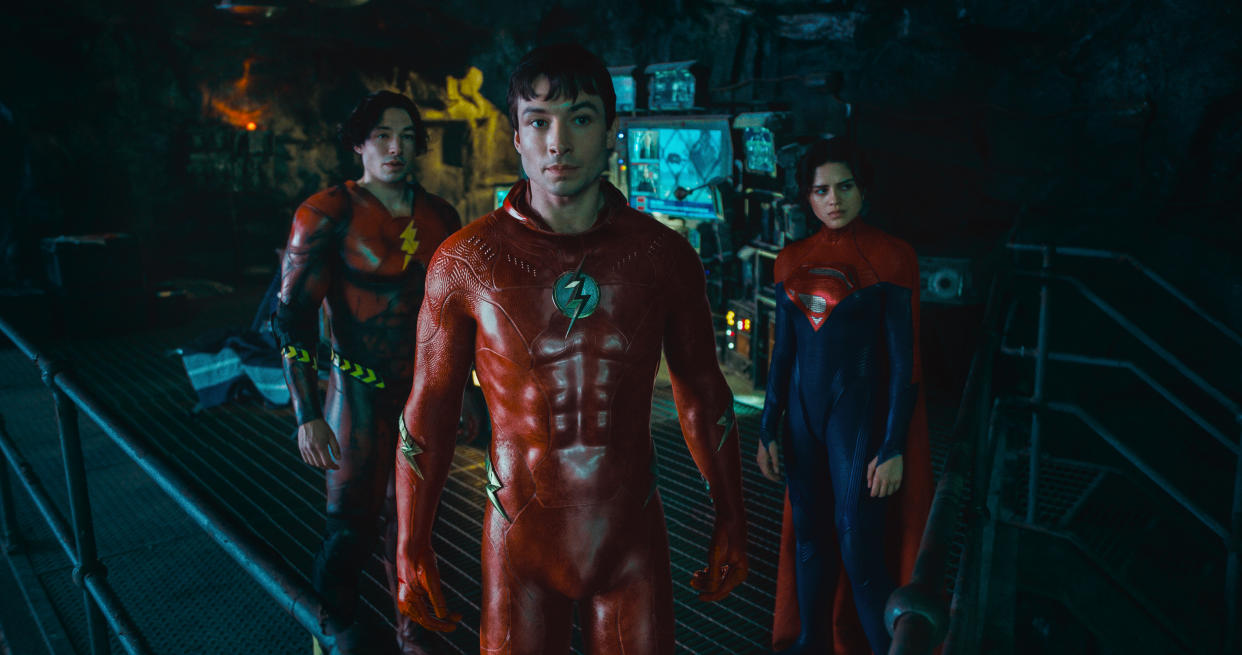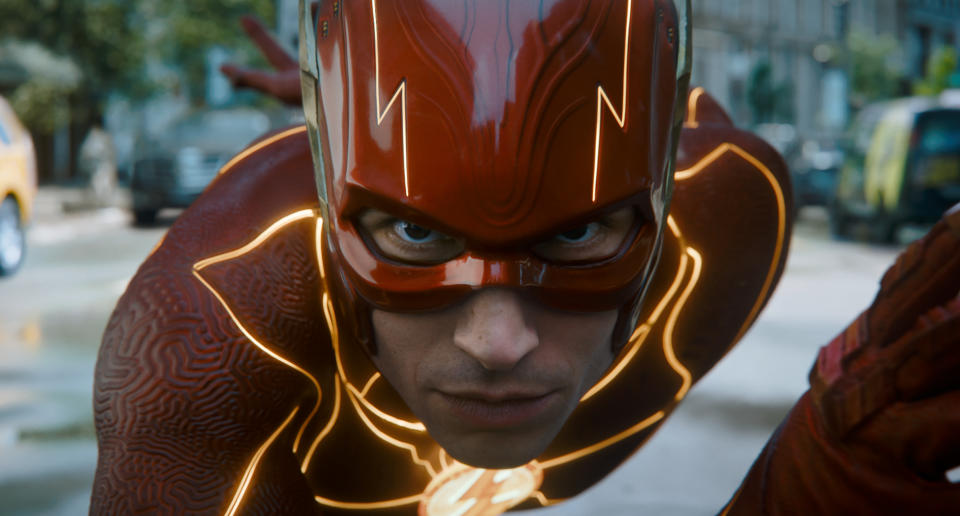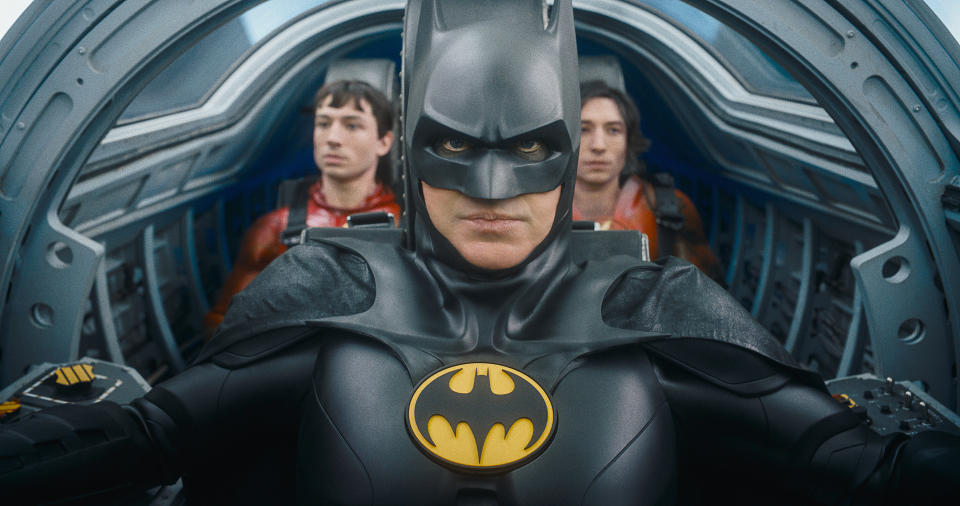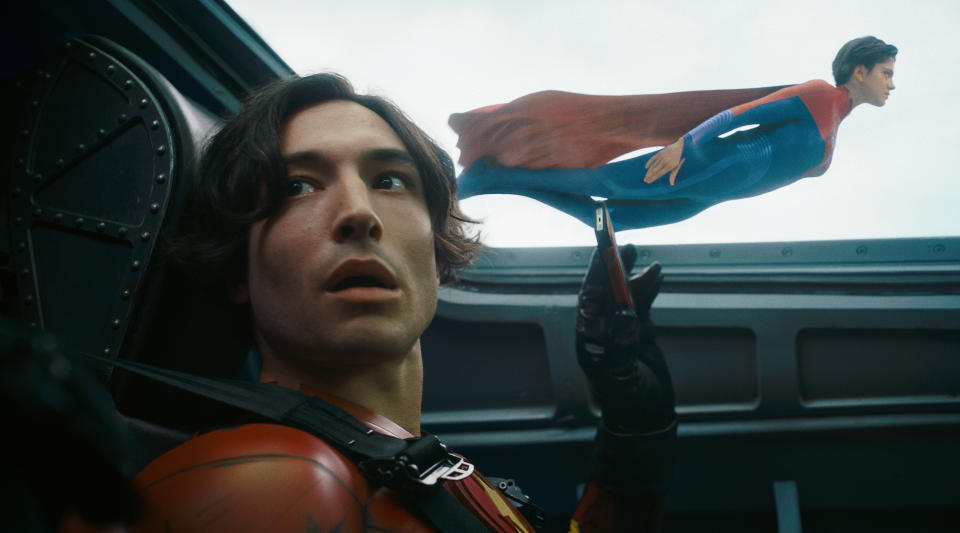‘The Flash’ Review: DC’s Trip Into the Movie Multiverse Is Wild, Weird, and Ultimately Wearying

- Oops!Something went wrong.Please try again later.
- Oops!Something went wrong.Please try again later.
The release of DC’s “The Flash” comes at a particularly complicated time for the superhero outfit — there’s the myriad documented concerns, both potentially criminal and definitely personal, that have plagued star Ezra Miller, plus the issues that have pushed DC Studios into a moment of change and upheaval — but perhaps the most immediate worry is that the film arrives on the heels of another superhero blockbuster that covers similar ground, and does it better by nearly every metric.
That other film is, of course, last week’s smash hit “Spider-Man: Across the Spider-Verse,” which marks a high-water mark for both Marvel and the superhero sub-genre dedicated to the multiverse movie. Just two weeks after that film’s release, here comes “The Flash,” already a tenuous bet, and now forced to directly compete with the best example yet of what this sort of feature can accomplish.
More from IndieWire
Yet, taken on its own merits, Andy Muschietti’s film has lots to offer, and frequently shows flashes (apologies) of brilliance that set it a cut above most of its existing DC Universe brethren. In its best moments, the film is funny, ambitious, and heartfelt, but it’s also frequently buried under iffy effects, convoluted storytelling, and a been-there-done-that familiarity that’s hard to shake. Just days after so many superhero fans were reminded of the possibility of the genre, “The Flash” mostly feels like a great example of a dying breed of blockbuster joint. It’s, somehow, already dated.
The rise of the multiverse is nothing new in the entertainment world — it’s not even new to DC, which has toyed with the concept throughout its many television offerings, including its very own nine-season “The Flash” series — but Muschietti’s film marks the first time the studio has gone all-in on this brand of storytelling in cinematic form. The screenplay, from “Birds of Prey” and “Bumblebee” screenwriter Christina Hodson (with story credits to Joby Harold, John Francis Daley, and Jonathan Goldstein), is a literally classic one, spinning off the iconic “Flashpoint” comic book storyline into DC’s first-ever standalone feature dedicated to The Flash / Barry Allen (Miller). Miller’s Flash has already appeared in a trio of other DC films, but Muschietti’s feature offers the character (perhaps this is a good time to note that, while Barry Allen is male, Miller identifies as non-binary and uses they/them pronouns) the chance to fully inhabit his own story for the first time.
A high-energy opening sequence steeps us in Barry’s everyday life, from the necessity of a high-caloric breakfast (and a natty smartwatch that tells him when his energy is running low) to the high levels of popularity he enjoys when he’s in his super suit (he’s basically a nobody when he’s out of it), as the speedster is dispatched to help Batman (Ben Affleck) and Alfred (Jeremy Irons) during a Gotham-set hospital disaster. It’s a wonderful kick-off, showing off The Flash’s prodigious powers and his wily sense of humor, as he cracks wise about being the Justice League’s janitor while also saving a pack of babies in increasingly ingenious ways.

But, as is so often the case with our most powerful superheroes, Barry is haunted by his past, which includes a) a dead mother and b) a father who was convicted of her murder and has been in jail ever since. How haunted is Barry? So haunted that even a grizzled Bruce Wayne (Bruce Wayne! the world’s most haunted superhero orphan!) basically tells his young charge to move on, a hard lesson Barry is in no way ready to take to heart. And why should he? Because when Barry puts on that suit, cycles through some heartbreaking memories of his mother’s demise when he was just a kiddo, and runs fast enough, he discovers something wild: he can turn back time.
“The Flash” opts for an ambitious — and, we’re guessing, potentially divisive — way of showing off Barry’s time-turning powers: when he runs fast enough, he lands in a massive amphitheater (eventually referred to as the “Chronobowl”) in which every iteration of Barry’s life, every possible universe, flows up and out. All he has to do is run fast enough and far enough, and he can pick which moment to pop back into. Like, oh, perhaps the moment his mother forgot to buy a can of tomatoes, which ultimately led to her death in the Allen family home all those years ago? Barry, for all of his smarts, can’t deny what his heart wants: to save his mother, to save his father, to save himself.
If you’ve seen even one other time travel movie, you know where this is going, though with a bit of a twist. Barry goes back in time, pops the can of tomatoes into his mother’s shopping cart, and then zips ahead to rejoin her in his current timeline. Except, it’s not his current timeline (he’s about a decade too early), and when he arrives back at the Allen casa, he’s met with a happy mother (Maribel Verdú), a happy father (Ron Livingston), and a very confused younger Barry (also Miller, now sporting a floppy haircut and a laidback attitude). But while Barry did save his mom, he also upended just about everything else in the process, to the extent that there’s no longer a Justice League, and thus, no one there to save Earth when Michael Shannon’s evil General Zod (last seen in 2013’s “Man of Steel”) arrives, World Engine and all. The butterfly effect, heard of it?

Other things have changed, too, flourishes that run the gamut and are often quite funny and clever — this timeline includes everything from a fast casual joint named “Bananabee’s” to a “Back to the Future” franchise that really did star the originally-cast Eric Stoltz (Michael J. Fox? Isn’t he the guy in “Footloose”? Kevin Bacon? No, no, he’s the star of “Top Gun”!) — original enough choices that add real pop to an otherwise heady storyline. But Barry (and, yes, Other Barry) have too many problems to really enjoy them, including yet another major roadblock: Other Barry doesn’t have powers, and when he finally gets them, our original Barry is left without them. Sounds like a fun fight for General Zod.
Enter: Michael Keaton, kinda-sorta reprising his Batman here, this time(line) rendered as a hermit who turned away from public life after his Gotham got healed up. Still, he’s a bonafide superhero, and a bit of a genius when it comes to unpacking the complex time-travel concepts and ideas at play here — many of them explained by Keaton and a fresh bowl of spaghetti, actually one of the film’s most clear-eyed metaphors — and the Barrys really need him. (Soon enough, they’ll get another pal, too: Sasha Calle as a stern Kara Zor-El, aka Supergirl.) But as the wacky foursome embark on their quest to save the planet, defeat Zod, and (maybe) set things right, “The Flash” lands on its most compelling element, which also happens to provide a thrilling counterpoint between DC and Marvel’s unfurling and competing multiverses.
(Small spoiler alert for “Spider-Man: Across the Spider-Verse” here.) In “Across the Spider-Verse” the breaking of “canon” — changing the core events that are duplicated in the life of every Spidey, from being bitten by a radioactive spider to losing a close compatriot who happens to be a police captain — is so dangerous that it has the power to rip the very fabric of the multiverse itself. Changing these key plot points is so horrifying that it’s basically forbidden, but it is possible. In “The Flash,” the concept of canon events is flipped on its head: Bruce calls them “inevitable intersections,” essential moments that occur in every timeline, no matter how many tweaks Barry (or whoever) tries to throw at them.

Trying to change these key plot points is indeed scary, but it’s not forbidden, mostly because it’s not possible. Some pieces are malleable — like, for instance, how old Bruce Wayne is or what he looks like (read: which big star is playing the role, Ben Affleck to Michael Keaton, and maybe more) — but there’s still always a Bruce Wayne, there’s always a Batman. That essential stuff, that canon cannot be broken, even if Barry believes he has the tools to do so. And that concept is pushed and pulled — or, in the parlance of one of the film’s most eye-popping and brain-breaking sequences, “collided and collapsed” — throughout the course the film’s big! scary! final! battle! It’s exciting and weird, until it’s repetitive and tiring. It’s wild, until it’s wearying. And it’s original enough, until it simply starts cannibalizing itself.
Part of the problem: the way this all looks and moves. This particular story doesn’t work without two Barry Allens and Miller, for all their off-screen troubles, does turn in wonderful, funny, soulful performances in both iterations, but this ambitious idea isn’t entirely supported by the technology at hand. Once you start seeing the seams, the moments when Miller’s face is obviously stitched on another body, when these two superheroes are clearly not in the same room (of course such a thing is not possible, but what of the possibility of movie magic in tricking us to think it?), when the artifice of this entire outing is lost to fuzzy effects, it’s all too easy to fall out of the feature.
And then? You can’t help but see more seams, more problems, more cracks. And, as is the case with most time travel stories, the less time you spend trying to understand and untangle how it all works, the better. Once that veil is lifted, it’s hard to fall back into the film (to say nothing of the itchy feeling inspired by its ending, probably once very fun and tongue-in-cheek, but that now feels utterly played out and exhausting).
“Don’t live your past, live your life,” Affleck’s Bruce Wayne tells Barry early on, a forward-thinking mantra the entire superhero machine would do well to follow. In its best moments, “The Flash” touches on something new and exciting, but too often, its the past that tugs on, keeping it from speeding ahead.
Grade: B-
Warner Bros. will release “The Flash” in theaters on Friday, June 16.
Best of IndieWire
Sign up for Indiewire's Newsletter. For the latest news, follow us on Facebook, Twitter, and Instagram.

